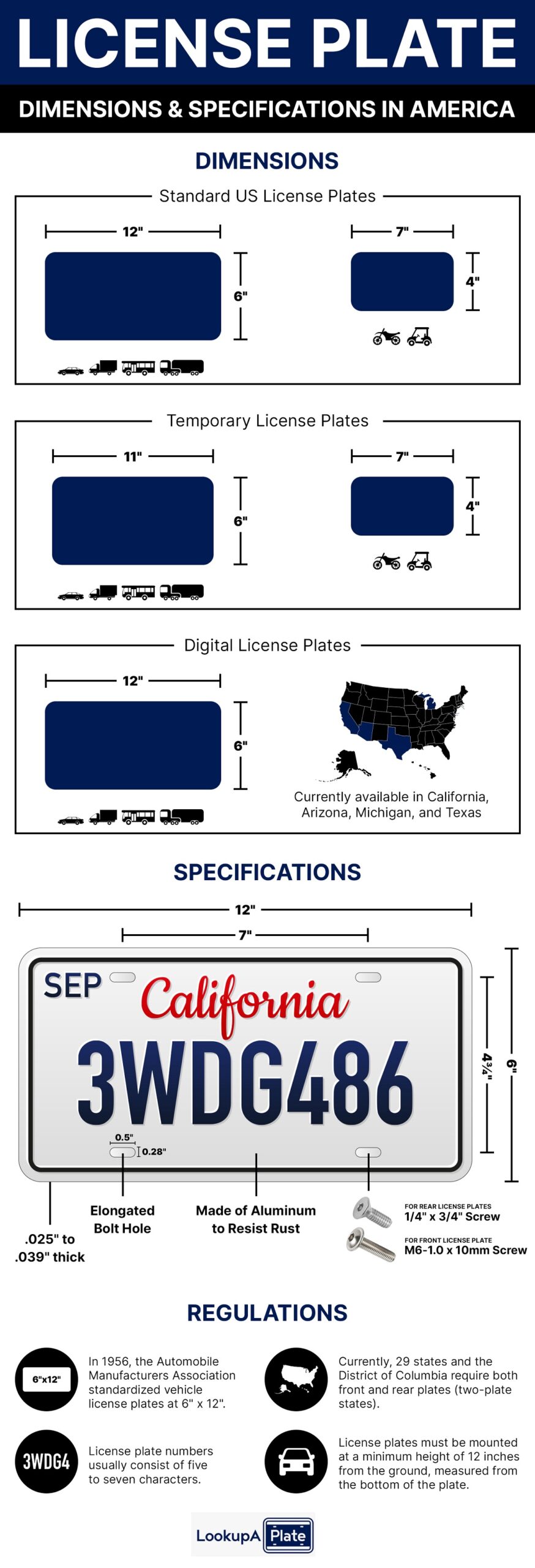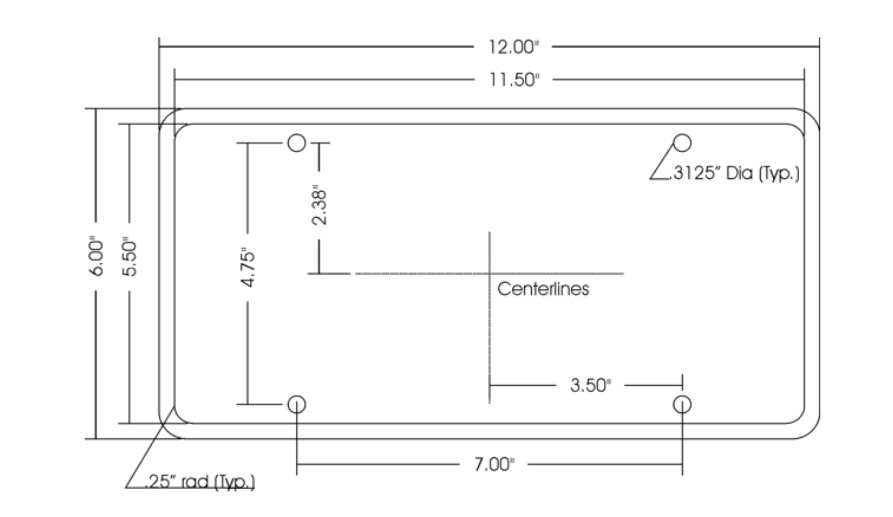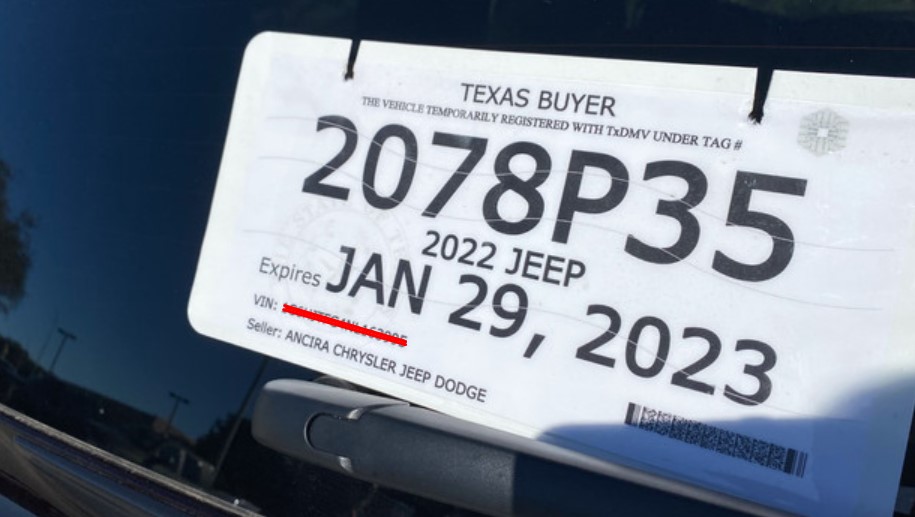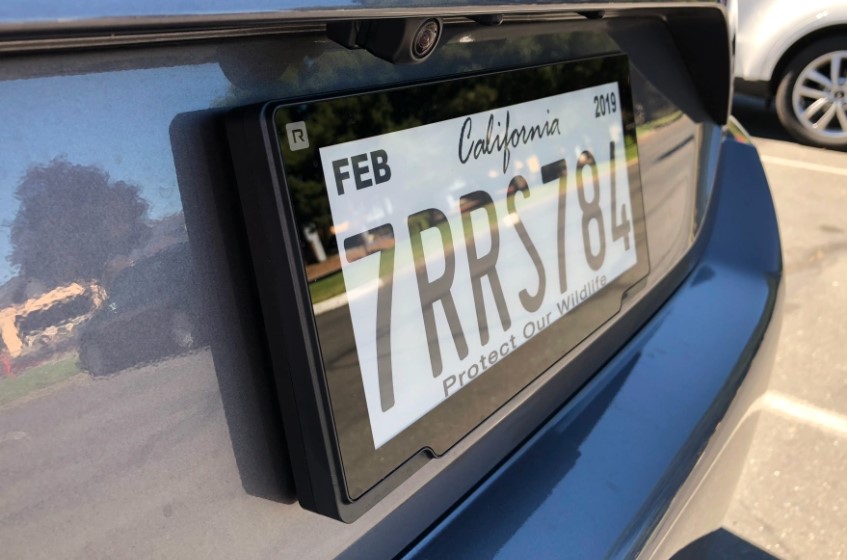License plates do not tend to catch our attention, even though we are on the road almost daily, either in our vehicles or on public transportation. Yet, there is a lot to know when it comes to license plates, and that is why we’ve provided you with the ultimate guide to license plate sizes and dimensions.
What are license plates?
License plates, sometimes referred to as number plates, are usually five to seven character-long alphanumeric signs assigned to each registered vehicle in the US for identification of the vehicle and the vehicle owner.
License plates are issued by the respective state DMV and are affixed to the vehicle’s front and/or rear. An estimated 294 million license plates have already been issued in America by 2022.
You may wonder why we need a license plate in the first place.
A license plate is a unique identifier meaning no two vehicles can have the same license plate number. A license plate record has vehicle identification information, such as make, model, year, vehicle identification number (VIN), and vehicle owner’s details.
The data associated with a license plate can help:
- Public safety – Authorities track the vehicle and vehicle owner to enforce traffic laws or, in case of violations
- Find the registration status of the vehicle
- In regulatory compliance, such as registration, taxation and insurance
- Toll collection and efficient traffic management
Now that you have a bit more idea about license plates, let’s look into license plate dimensions. We’ve also included a handy infographic for easier reading.

What size are license plates in America?
Standard license plate dimensions in US measure 12” x 6” (30cm x 15cm). Cars, buses, trucks, and trailers have the standard-sized license plate. So all states in America, as well as vanity/personalized license plates, have the same license plate dimensions (graphics may vary).
The license plate number usually consists of five to seven alphanumeric characters, with the exception of California, which has eight character limit.
License plate specifications:
- All license plates in America are made of reflective aluminum sheets.
- License plates are typically 0.027” to 0.032” (0.68mm to 0.8128mm) thick.
- They usually weigh 0.22 pounds, but older plates could weigh up to 0.50 pounds.
- The dimensions for the printable area of the license plate are 11.44” x 5.44”.
- Characters on standard license plates are usually 1.0000” (width) x 2.5625” (height).
- The spacing between characters is 0.375”.
- 1/4″ radius rims.

License Plate Screw Size
License plate screws vary based on car make and model and are not universal. However, below we listed the most common screws usually used for standard license plates.
- The screws for the front standard license plates are M6-1.0 x 10mm.
- The screws for rear standard license plates are ¼” x ¾”.
License Plate Bolt Hole Size and Spacing
- The standard license plates have elongated bolt holes.
- Each bolt hole on a standard license plate is ½” width x 0.28” height.
- Horizontal spacing: 7” between the center of the left-side and right-side bolt holes.
- Vertical spacing: 4 ¾” between the center of the upside and downside bolt holes.
What size are motorcycle license plates?
Motorcycle plates, as well as golf cart plates, are smaller than standard license plates. In US, the motorcycle license plate dimensions are 7” x 4” (17cm x 10cm). However, Minnesota is an exception, with dimensions that measure 7-3/16” x 4-3/16”.
Motorcycle License Plate Screw/Fastener Size
- The screws for motorcycle license plates are M6, 1.0 x 16mm.
- The screws are approximately ¾” long.
Motorcycle License Plate Bolt Hole Size and Spacing
- Each bolt hole on a standard license plate is 5/16” x 5/16”.
- Motorcycle license plates have circular bolt holes.
- Horizontal: 5 13/16” between the center of the left-side and right-side bolt holes.
- Vertical: 2¾” between the center of the upside and downside bolt holes.
What size are temporary license plates?
Temporary license plates for cars, buses, trucks, and trailers measure 11” x 6”, and temporary motorcycle license plates are 7” x 4”.
Depending on how long the temporary license is valid, the material may vary to discourage the fraudulent use of temporary licenses. Most temporary licenses are made from Teslin Substrate, which is a kind of synthetic paper. They are designed to be durable through all-weather to ensure readability; there is Teslin TS (Thermally Stable) and Teslin IJKP (Inkjet Waterproof). Owners display these number plates in the same location as they would their permanent license plates.
Unfortunately, temporary license plates are prone to abuse; according to CBS News, people often use these licenses to conceal their identity during criminal activity, to drive uninsured cars, or even to drive cars that are deemed unsafe for the roads.

What size are digital license plates?
A digital license plate has the same standard license plate dimensions of 12” x 6”. They are legal to use in all states, but they are currently available in California, Arizona, Michigan, and Texas.
As the name suggests, digital license plates have a digital display that shows the vehicle’s license plate, as well as the status of registration. They can be wired into the car’s electrical system or battery-powered, which lasts up to five years.
People invest in digital license plates because they make registration more convenient and they are trackable. However, digital plates are more expensive than their traditional counterparts costing anywhere from $19 to $24 per month.

When was the license plate size regularized?
Originally, license plates were made from various materials such as leather or metal. Although they were used in all of the contemporary 48 states by 1918, there was no standardization between states; the plates would usually have an abbreviated form of the state name, the year, and the registration number, but the plates varied from place to place.
The Vehicle Identification Number (VIN) was introduced in 1954 to link registration documents to a particular car. Shortly after this, in 1956, the Automobile Manufacturers Association standardized vehicle license plates at 12” x 6” for all American and Canadian vehicles.
Are all license plates of the same size in the USA?
After the standardization of license plate dimensions in the United States, all states’ license plates are the same size at 12” x 6”.
This being said, there are some variations between states on whether to have a front license plate or not. Most states are two-plate states, but many states are moving to require only a rear plate.
Consult the chart below or check out the article on our website to see which states do and don’t require two plates.
One-Plate States | Two-Plate States |
Alabama Arizona Arkansas Delaware Florida Georgia Indiana Kansas Kentucky Louisiana Michigan Mississippi New Mexico North Carolina Ohio Oklahoma Pennsylvania South Carolina Tennessee West Virginia | Alaska California Colorado Connecticut Hawaii Idaho Illinois Iowa Maine Maryland Massachusetts Minnesota Missouri Montana Nebraska Nevada New Hampshire New Jersey New York North Dakota Oregon Rhode Island South Dakota Texas Utah Vermont Virginia Washington Washington, D.C. Wisconsin Wyoming |
How big are license plates around the world?
The license plate dimensions aren’t standard across the globe, and in fact, America has smaller license plates compared to most other countries.
Here’s what license plate dimensions look like for other countries:
Country | Standard License Plate Dimensions |
| India | 340mm x 200mm (13.3″ x 7.8″) |
| Chile | 360mm x 130mm (14.2” x 5.1”) |
| Australia | 372mm x 134mm (14.6” x 5.3”) |
| South Korea | 335mm x 170mm (13.2” x 6.7”) |
| United Kingdom | 520mm × 111mm (20.5” x 4.4”) |
| China | 440mm x 140mm (17.3” x 5.5”) |
| France | 520mm x 110mm (20.5” x 4.3”) |
| Argentina | 400mm x 130mm (15.75” x 5.12”) |
| Japan | 330mm x 165mm (13” x 6.5”) |
| Indonesia | 460mm x 135mm (18.1” x 5.3”) |
| Israel | 360mm x 110mm (14.2” x 4.3”) |
FAQs
Still have questions? We have answered some more frequently asked questions about license plates in the United States.
Q: Are front and back license plates the same?
A: The standard license plate dimensions, as well as the characters displayed on the license plates, are the same for front and rear license plates. However, keep in mind that the mounting screws for each may vary between the two, as well as between vehicles.
Also, since not all states require a front license plate, some vehicles do not have brackets for mounting at the front. You can buy these separately from your vehicle to screw into the front tow hook if that is the case with your car. Remember to consult our chart or article to see if your state does or does not require a front number plate.
Q: Are all license plate frames of the same size in the USA?
A: As standard license plate dimensions are 12” x 6”, most license plate frames are universal, measuring 12-¼” x 6-⅜”. These perfectly fit the standard number plate.
Your license plate frame should have elongated cutouts for mounting bolts. Also, make sure that your license plate frame does not block your registration tags because these must be visible by law; since states have different license plate designs, be sure to check your license plate before purchasing a frame to avoid covering up your registration tags.
Q: What font is used on the license plate?
A: The font used on American license plates varies from state to state to avoid easy copying. Most states have their own custom font. For example, Alabama uses URW BaskerTwid, which is similar to Times New Roman; North Carolina uses one of the variations of Advertisers Gothic; Massachusetts uses a variation of clearface bold italic.
The states also use different fonts for the header on their license plates, which dictates the state’s name.
Conclusion
Didn’t realize there was so much to know about license plates? We did! This guide is meant to help you whether you move states, lose a screw, or wonder about different types of license plates. Knowledge is key, and when it comes to your vehicle, the more you know, the safer and more prepared you will be.
Do not underestimate the importance of license plates as well as the intricacies behind the plate.
Sources:
- https://www.aamva.org/getmedia/3514b445-1f2e-45c4-a785-49d9926e2f4e/License-Plate-Standard,-Edition-2-Revised.pdf
- https://www.dol.wa.gov/vehicleregistration/docs/specialty-plate-design-guide.pdf
- https://multimedia.3m.com/mws/media/301113O/digital-license-plate-design-guide.docx
- https://www.newsweek.com/what-are-digital-license-plates-how-do-they-work-1717039
- https://www.elicenseplateframes.com/faqs/general/which-license-plate-frame-right-my-state/
